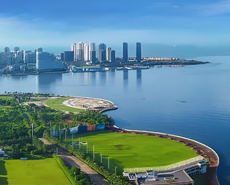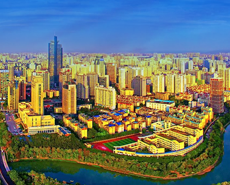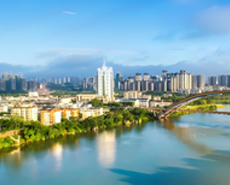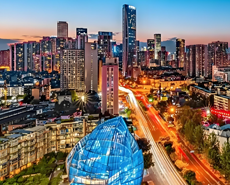
Establishment of legitimate recycling network for waste lead-acid battery is the foothold for stable secondary lead production
----Interview with Zhang Shiyan
Deputy General Manager
Hebei Gang’an Environmental Technology Co., Ltd.
Hebei Gang’an Environmental Technology Co., Ltd. was founded in July 2009 based on registered capital of RMB79.35 million. The company was listed as a key enterprise in 2009 and “3255” circular economy demonstration project in Hebei as well as “resource-saving and environment-friendly" model enterprise in Hebei in 2011 by local provincial government. Approved by clean production audit and safe production acceptance in 2013, the company was named as “the leading enterprise in industrial clusters in Hebei province”, “Hebei provincial-level circular economy demonstration enterprise” and “top 100 private enterprises in Hebei province”. Honored as ““top 100 private enterprises in Hebei province” in 2014, the company achieved annual sales of RMB1.5 billion in the same year, also one of the three enterprises approved by China in national environmental inspection. In October 2016, the company was listed in Demonstration Enterprises of Coordinated Development of Industries and Comprehensive Utilization of Industrial Resources Industry in Beijing, Tianjin and Hebei.
Asian Metal: First of all, please introduce the main business of the company.
Zhang: We are the subsidiary of Zhengxu Non-ferrous Metal Co., Ltd. and CHNWIN (Hongkong) Co., Ltd. In addition, Hebei Jinyusheng Recycling Co., Ltd., the subsidiary of Anxin County Shangshangfang Recycling Co., Ltd., is our brother company and the dealing capacity of waste lead-acid battery can reach a total of 360,000tpy from the two companies with 180,000tpy for each. We introduced the global-leading CX preprocessing integrated system from Italy to recycle waste lead-acid battery and our major products include lead alloy, secondary refined lead, lead paste and other plastic products.
Asian Metal: As far as we know, the current raw material supply of secondary lead is unstable and secondary lead output from certain smelters mainly relies on purchases of raw material. How about your raw material supply?
Zhang: The problem in raw material supply has been relieved since the environmental inspection started from H2 last year and the supply can generally support our stable production. We can deal with 400tpd of waste lead-acid batteries at present with capacity of more than 11,000tpm. Some illegal enterprises are still in production suspension currently due to the Spring Festival holiday and we have no difficulty in sourcing raw material temporarily.
Asian Metal: According to sources, about 1.1 million tons of secondary lead capacity can be constructed this year and around 50% will be put into production. Will this affect your raw material purchases for secondary lead production?
Zhang: The impact will not be too significant, which will be determined by the further environmental inspections in China. Affected by supply channels of raw material, the processing capacity from standard secondary lead smelters is still limited. Yuguang Gold&Lead processed more than 200,000t of waste lead-acid battery in 2016 and the total volume can reach only about 1 million tons per year coupled with capacities of our company and other surrounding standard companies in Hebei province. The total number for waste lead-acid batteries is 5-6 million tons and thus most finally go to illegal companies.
Raw material purchase is closely related with the environmental inspection. Small smelters will suspend production when inspection is tighter, leading to lower pressure in purchasing waste lead-acid battery and vice versa. We purchase raw material through the same channel, but they are more advantageous in sales than us as our production cost resulted from input in in hazardous waste disposal, enterprise management, operation, etc. As a result, we fall behind illegal smelters in competition.
Asian Metal: From the perspective of supply channel for waste lead-acid battery, we expected that most domestic enterprises can’t be satisfied by current purchases and what do you think of this situation?
Zhang: The problem does exist, which can’t be solved temporarily. We hope to establish legitimate recycling network for waste lead-acid battery based on advocacy by Asian Metal, the government, news reporters, China Non-ferrous Metals Industry Association Recycling Metal Branch, etc. There are only 2-3 legitimate recycling networks in Hebei and surrounding regions and the supply of waste lead-acid battery can turn to be stable as long as quantities of networks can be set up. There is almost no illegal recycling network in Zhejiang at present and the supply of waste lead-acid battery is doomed to flow to standard enterprises.
Asian Metal: Lead prices surged to nearly RMB20,000/t (USD2,908/t) this week and what’s your opinion about the price trend in the near future?
Zhang: I think it is easy for the price to break RMB20,000/t (USD2,908/t) before the end of March, that is during the National People's Congress and the Chinese Political Consultative Conference (NPC&CPPCC) mainly impacted by the supply and demand. Environmental inspection will be strict before and during NPC&CPPCC. Currently, primary lead smelters restrict production in certain regions and inspection on secondary smelters is much strict from the government and related environmental authorities. Thus, the output of lead ingot will decrease, providing supports to lead prices. The price trend after NPC&CPPCC will still be determined by the environmental inspection, but I predicted that the price may fall back slightly in April.
Asian Metal: The environment protection has been upgraded in China in recent years and most illegal secondary smelters are forced to suspend production or shut down. However, quite a few of them are still in normal production in view of satisfactory lead prices. How will their production affect the overall lead ingot supply-demand relation and prices?
Zhang: I am not clear about the specific figure, but their capacity is almost in line with that of legitimate enterprises as far as I know. Although some smelters have been required to shut down in recent years due to environmental factor and some are in production suspension, once they raise capacity, lead prices will be decline for sure. The current raw material supply of lead remains tight at present and the output of secondary lead will gradually take a larger proportion in the future. Therefore, the proportion of primary lead output will shrink.
Asian Metal: What are the toughest problems faced by the secondary lead industry at present according to your opinion and how to solve them?
Zhang: The toughest problems are as follows:
The first problem goes to the persistence of environmental protection.
The second problem is that whether the country will increase subsidy in standard secondary lead enterprises. As long as China increases the subsidy, we will be competitive in competition with illegal secondary lead enterprises and the whole industry will gradually return to the right track.
The third problem is to establish legitimate recycling network for waste lead-acid battery to ensure stable secondary lead production. This problem is urgent, which I have mentioned before.
Asian Metal: What is the future development of Gang’an Non-ferrous?
Zhang: We are still in full production this year. We pay attention to not only profit, but also social responsibility. No matter whether we can make profit, we hope to deal with as more waste lead-acid batteries as possible to avoid the supply to illegal channel.
Asian Metal: Thanks for your sharing and supports to Asian Metal. Wish your business thriving.
Zhang: Thank you!
















